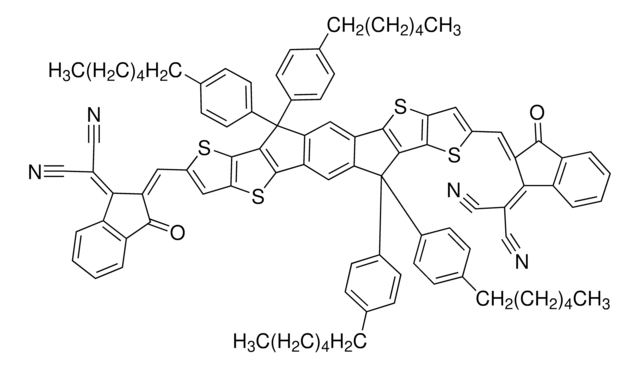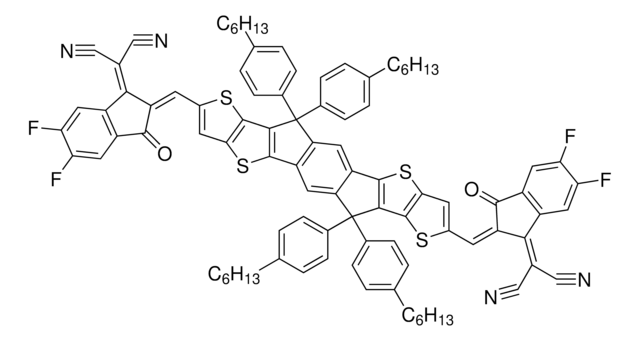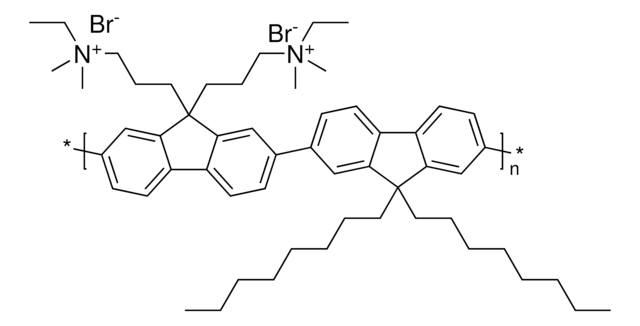906336
PBDB-T-2F
Synonym(e):
PCE135, PM6, Poly[[4,8-bis[5-(2-ethylhexyl)-4-fluoro-2-thienyl]benzo[1,2-b:4,5-b′]dithiophene-2,6-diyl]-2,5-thiophenediyl[5,7-bis(2-ethylhexyl)-4,8-dioxo-4H,8H-benzo[1,2-c:4,5-c′]dithiophene-1,3-diyl]-2,5-thiophenediyl]
About This Item
Empfohlene Produkte
Beschreibung
Band gap: 1.9 eV
Form
particles
Mol-Gew.
Mw 80,000-200,000 g/mol by GPC
Farbe
Fine
Löslichkeit
chlorobenzene: soluble
chloroform: soluble
dichlorobenzene: soluble
Energie der Orbitale
HOMO -5.5 eV
LUMO -3.6 eV
PDI
2‑4
Anwendung
Polymeric donor material
LUMO=−3.6 eV
HOMO=−5.5 eV
OPV Device Performance:
PBDB-T-2F: ITIC-F (1:1 w/w)
Voc= 0.84V
Jsc= 22.2 mA/cm2
FF= 0.725
PCE=13.5%
PBDB-T-2F (or PM6) is a wide bandgap polymer donor (n-type semiconductor) containing fluorinated thienyl benzodithiophene (BDT-2F) used in high performance polymer solar cells (PSCs). PBDB-T-2F possesses high crystallinity and strong π-π stacking alignment, which are favourable to charge carrier transport and hence suppress recombination in devices. PBDBT-2F based PSCs were reported to have thickness and area insensitive performance and is a promising candidate for large-scale roll-to-roll manufacturing of high-efficiency polymer solar cells.
For example, recently, new study have shown PBDB-T-2F:IT-4F(Sigma Aldrich Cat. No. 901423) based PSCs yielded an impressive PCE of 13.5% due to the synergistic effect of fluorination on both donor and acceptor, which is among the highest values recorded in the literatures for PSCs to date [1]. The PBDB-T-2F:IT-4F baed PSCs also showed good storage, thermal and illumination stabilities with respect to the efficiency. High efficiency of >11% was maintained for a wide range of film area and thickness. When paired with selenopheno[3,2-b]thiophene-based narrow-bandgap non-fullerene acceptor, an impressive efficiency of 13.3 % was obtained with thickness-insensitive feature.
It has also been previously reported, PBDB-T-2F when paired with narrow band-gap small molecule acceptor 2,2′-((2Z,2′Z)-((4,4,9,9-tetrahexyl-4,9-dihydro-s-indaceno[1,2-b:5,6-b′]dithiophene-2,7-diyl)bis(methanylylidene))bis(3-oxo-2,3-dihydro-1H-indene-2,1-diylidene))dimalononitrile (IDIC), the as-cast film (without extra treatments) showed an outstanding power conversion efficiency (PCE) of 11.9%, a record value for as-cast polymer solar cells. Moreover, the performance of PBDB-T-2F:IDIC based devices is insensitive to the active layer thickness (≅95-255 nm) and device area (0.20-0.81 cm2), and thus is a promising candidate for future roll-to-roll mass manufacturing and practical application of highly efficient PSCs.
It has also been reported, PBDB-T-2F possesses a strong absorption in the short wavelength region of 300-685 nm with a large bandgap of 1.80 eV, which is complementary to that of ITIC (1.55 eV) and facilitates achieving high short-circuit current (Jsc) in PSCs. Moreover, PBDB-T-2F shows a deep HOMO level of −5.50 eV, a strong crystallinity and a dominant face on packing, which helps to achieve a high open-circuit voltage (Voc) and fill factor (FF) in PSCs.
Lagerklassenschlüssel
11 - Combustible Solids
WGK
WGK 3
Flammpunkt (°F)
Not applicable
Flammpunkt (°C)
Not applicable
Hier finden Sie alle aktuellen Versionen:
Analysenzertifikate (COA)
Die passende Version wird nicht angezeigt?
Wenn Sie eine bestimmte Version benötigen, können Sie anhand der Lot- oder Chargennummer nach einem spezifischen Zertifikat suchen.
Besitzen Sie dieses Produkt bereits?
In der Dokumentenbibliothek finden Sie die Dokumentation zu den Produkten, die Sie kürzlich erworben haben.
Kunden haben sich ebenfalls angesehen
Artikel
Professor Chen (Nankai University, China) and his team explain the strategies behind their recent record-breaking organic solar cells, reaching a power conversion efficiency of 17.3%.
Unser Team von Wissenschaftlern verfügt über Erfahrung in allen Forschungsbereichen einschließlich Life Science, Materialwissenschaften, chemischer Synthese, Chromatographie, Analytik und vielen mehr..
Setzen Sie sich mit dem technischen Dienst in Verbindung.


![[6,6]-Phenyl C71 Buttersäuremethylester, Isomerengemisch 99%](/deepweb/assets/sigmaaldrich/product/structures/716/624/9fb9f2f0-ae99-429f-8d3a-b12267976a4d/640/9fb9f2f0-ae99-429f-8d3a-b12267976a4d.png)






![[6,6]-Phenyl C61 Buttersäuremethylester >99.9%](/deepweb/assets/sigmaaldrich/product/structures/359/221/d990c746-0960-4c69-bf76-fe09b193824d/640/d990c746-0960-4c69-bf76-fe09b193824d.png)